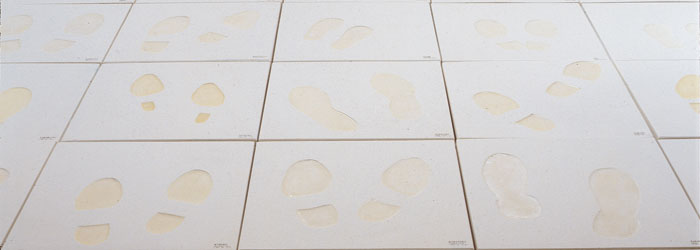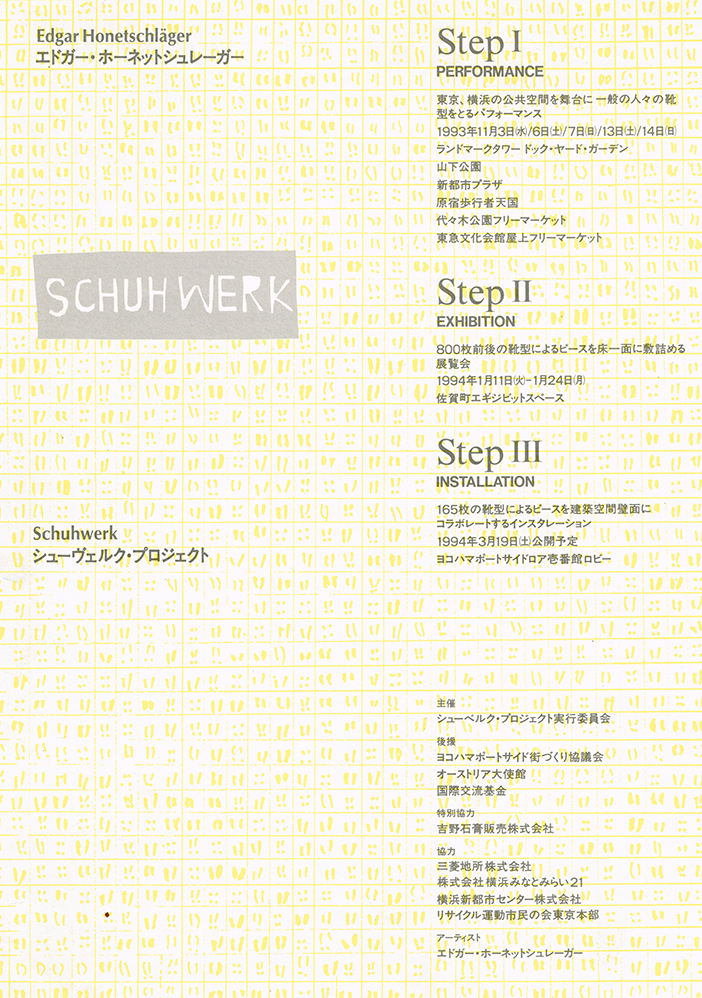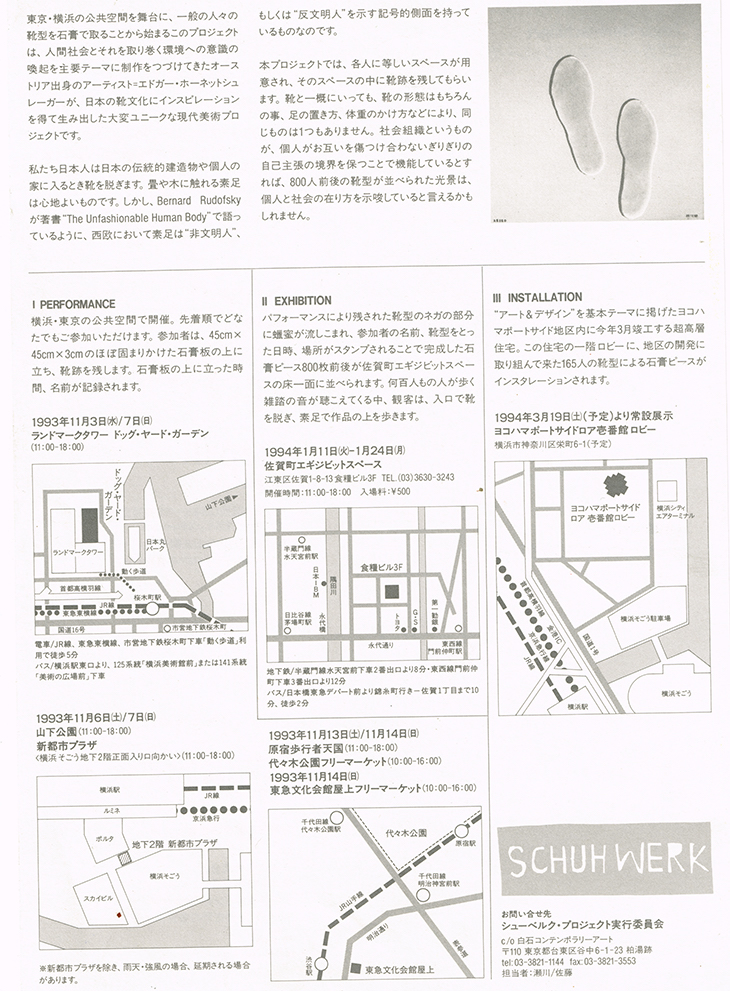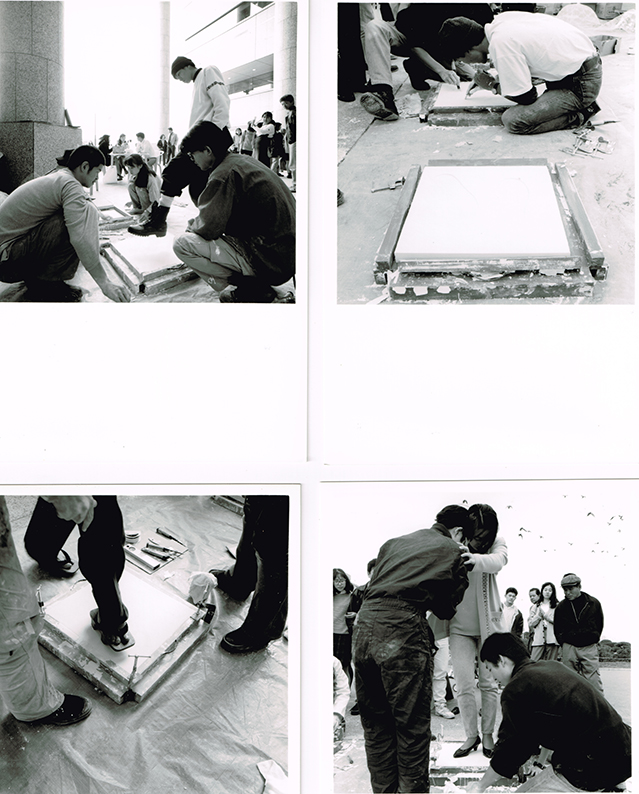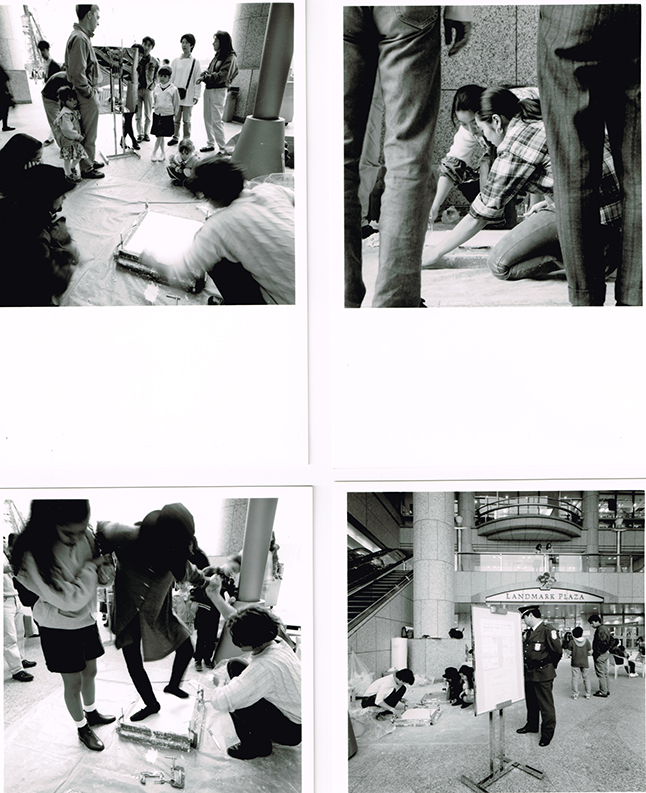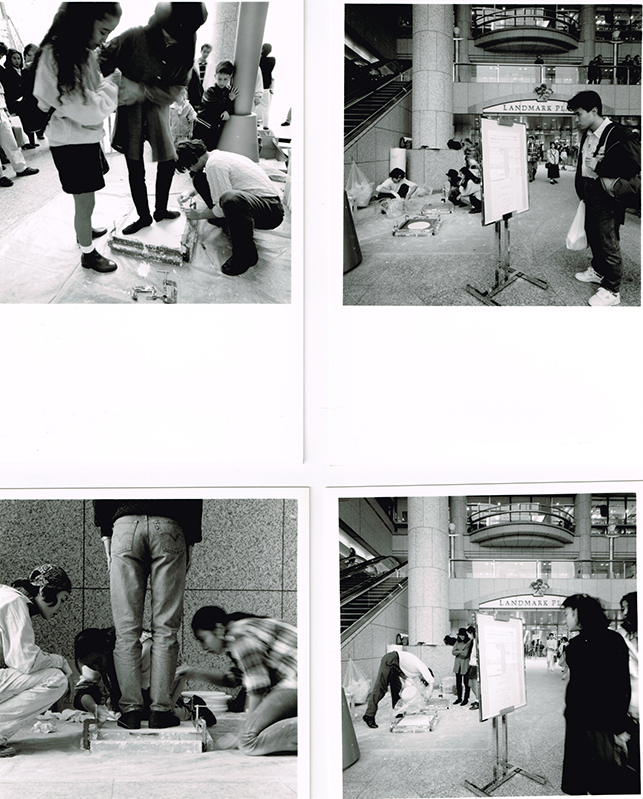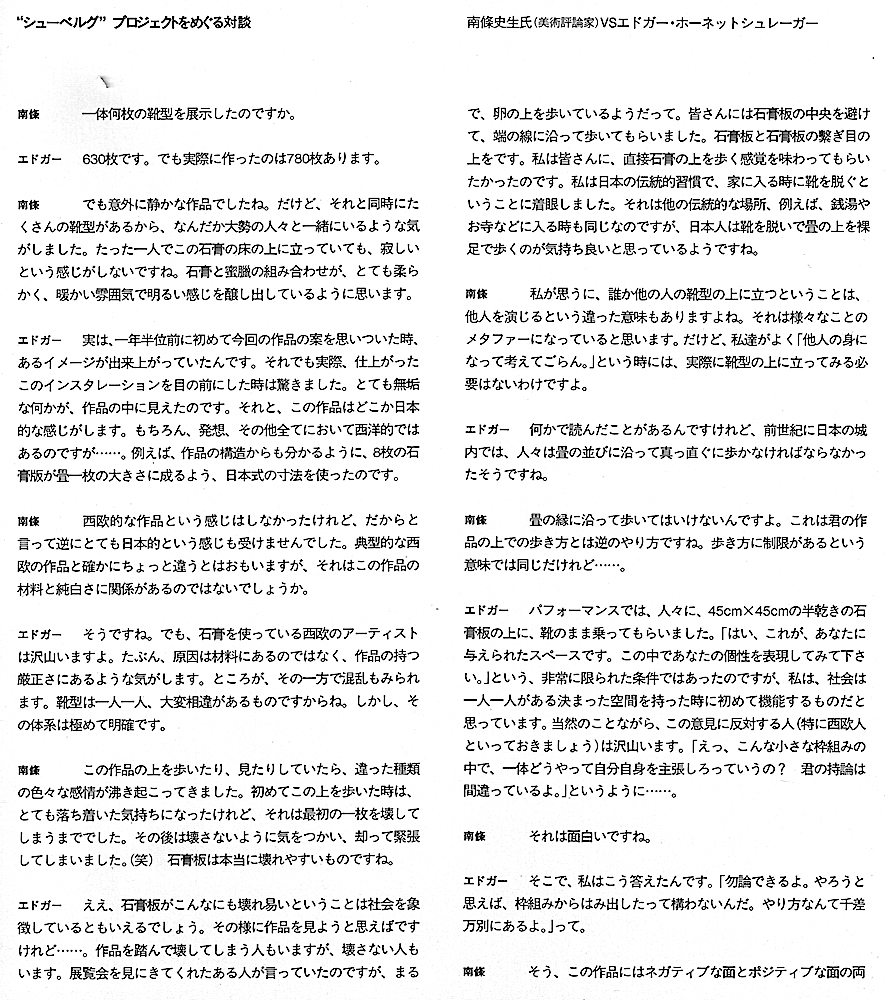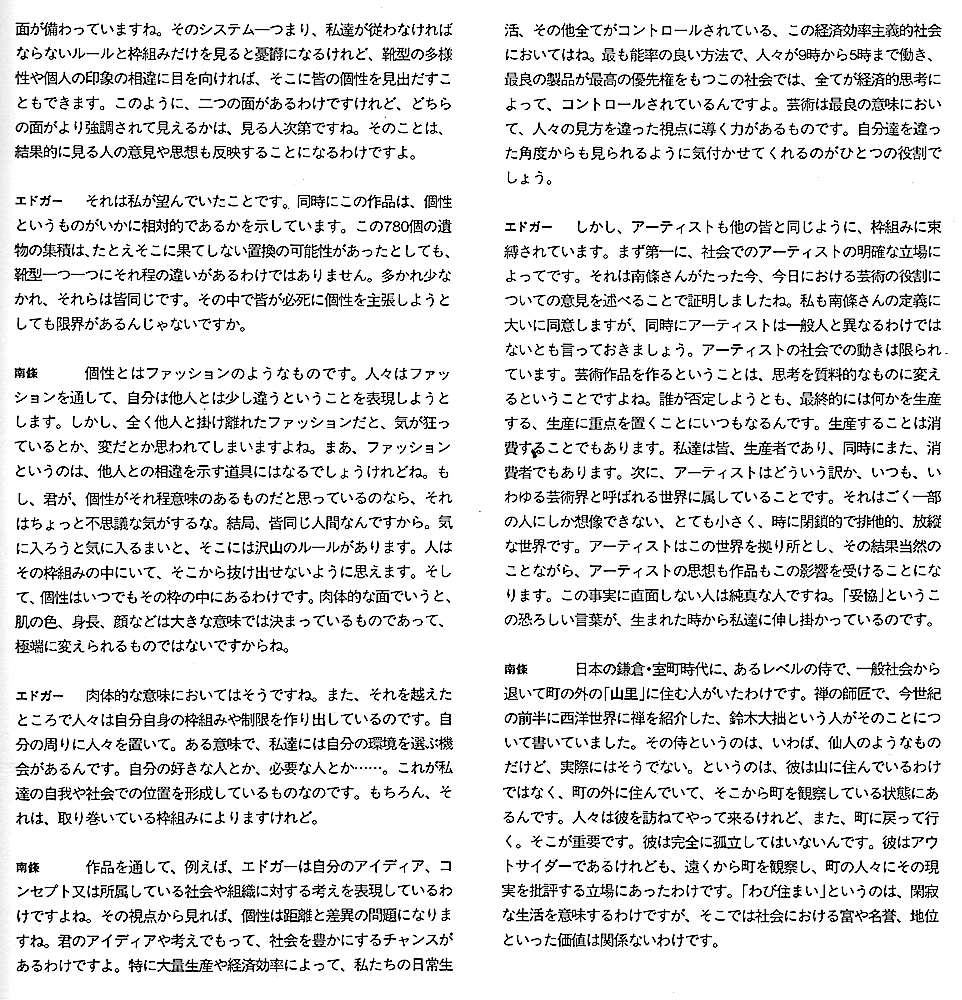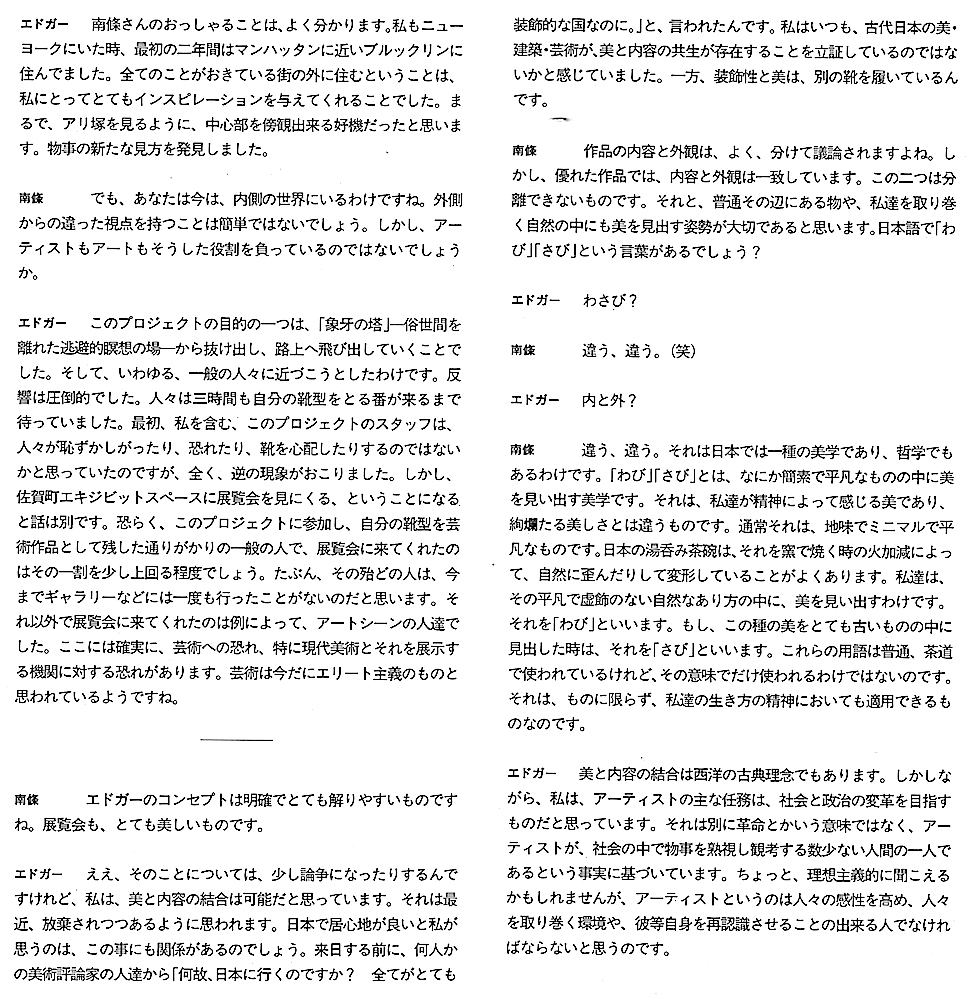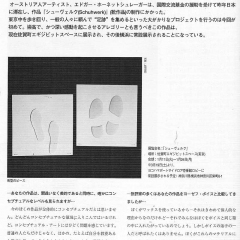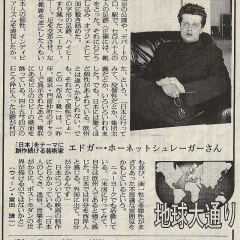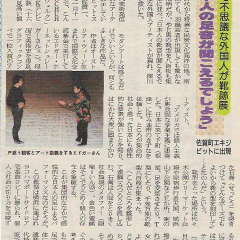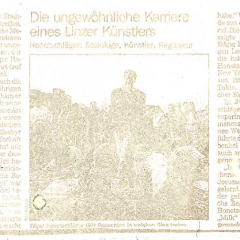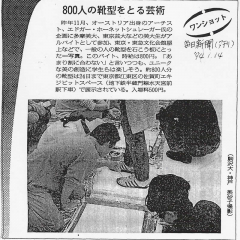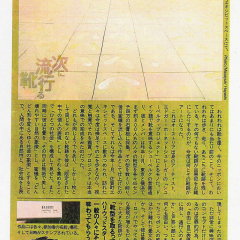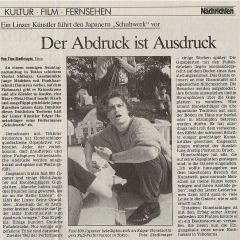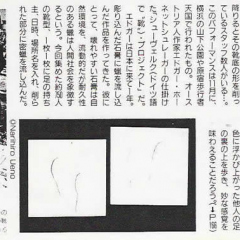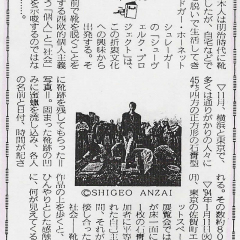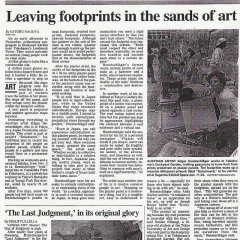Tokyo / Yokohama 1993/1994 (performance / installation)
In 1993/94 I realised the public art project SCHUHWERK in Yokohama city and Tokyo in collaboration with SCAI the Bathhouse. During a performance, that took place in seven different public spaces, passerbys were asked to step into 45 x 45 cm semi-dry PLASTER PLATES, leaving their FOOT PRINTS. The plates were prepared by 80 students from three different art universities (Tama, Musabi, Gedai) at the spot. 780 passerby’s participated. One of our aims was to get out of the ivory tower of art – into the street. We approached common people and the response was overwhelming: people would wait up to three hours for their chance to leave a footprint.

After they had left their mark, the footprints imbedded into plaster (standing for the fragility of nature) were filled with beeswax (standing for transformability of society). At the right bottom corner of each plate the first name of the participant, the time, the date and the location of participation was SILK SCREENED.
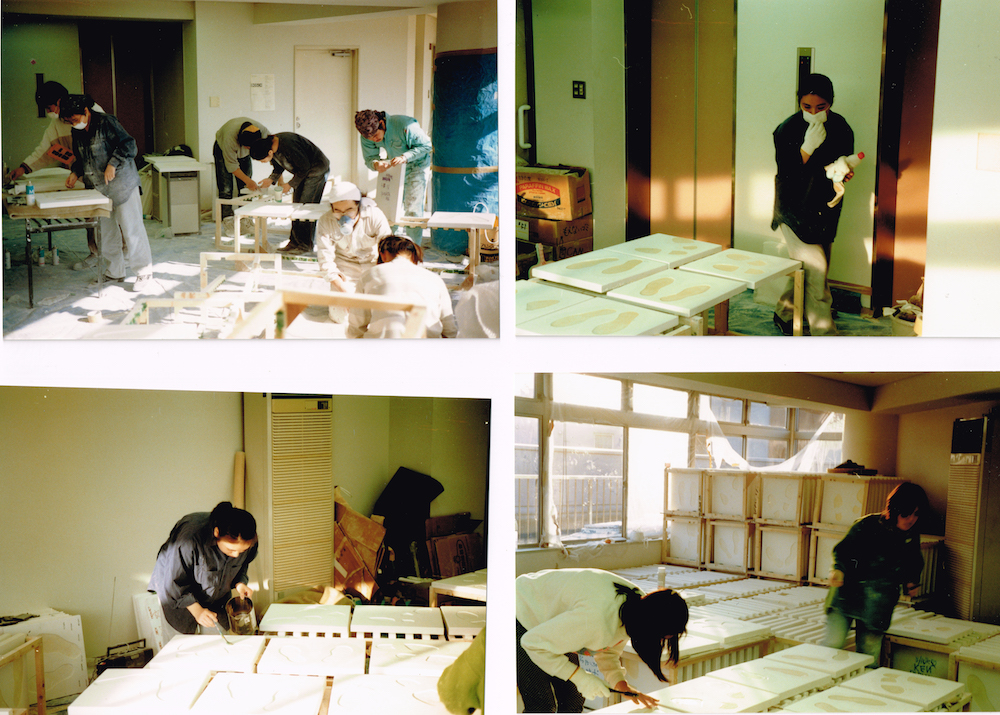
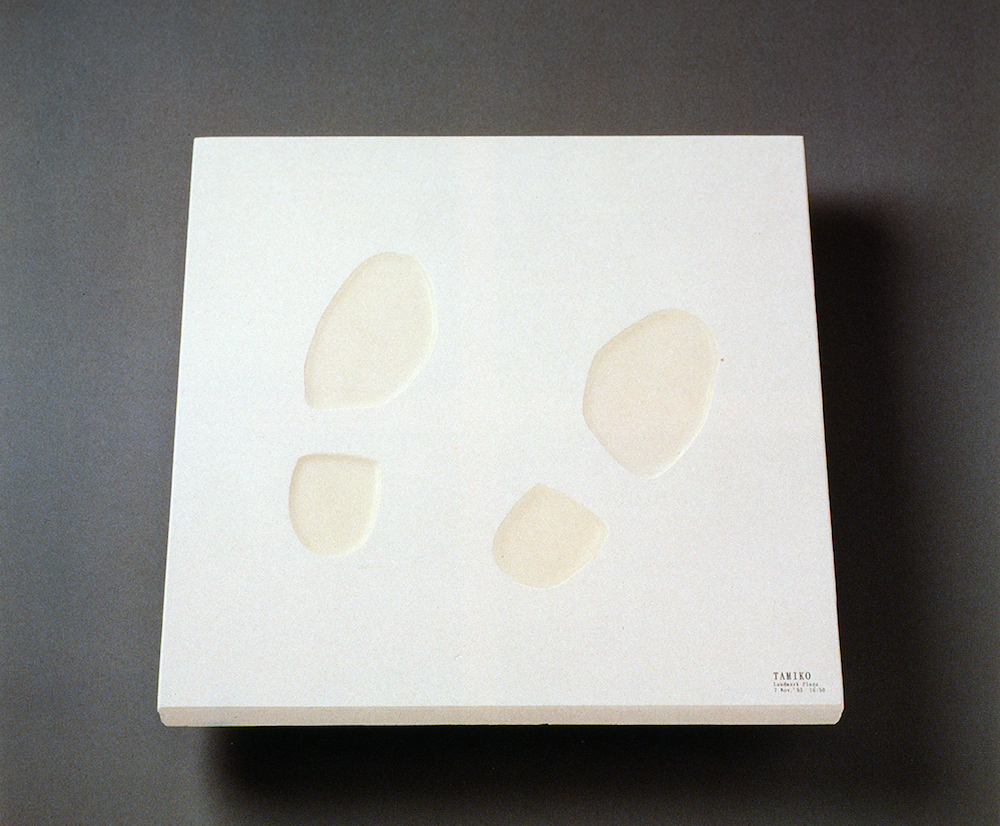
In a show at SAGATCHO EXHIBIT SPACE (the former rice exchange OF TOKYO) all those PLASTERplates were laid out. The people who had left their foot prints were invited, asked to take off their shoes and walk on the floor they themselves had created. The installation formed one big society – focusing on the dichotomies NATURE/CULTURE as well as INDIVIDUALISM/ CONFORMISM.


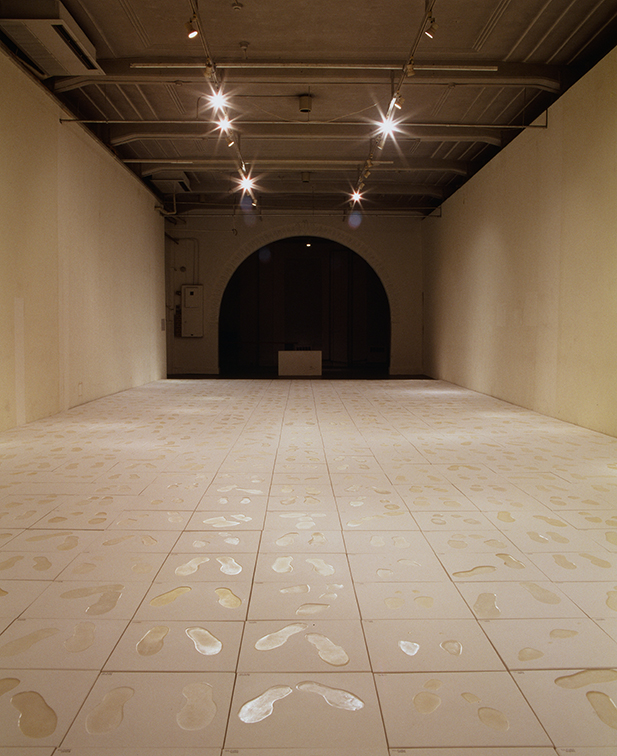
curator: Ritsuko Segawa
organiser: SCAI the Bathhouse / Masami Shiraishi
exhibition: Sagatcho Exhibit Space / Kazuko Koike
photography: Shigeo Anzai
special thank you to Mihoko Sugiura, Reiko Sugiura, Leza Lowitz
Realised with the help of Japan Foundation, The City of Yokohama, Yokohama Portside Urban Development Committee, Mitsubishi Estate co. ltd., Yokohama Shintoshi center, Austrian Embassy Tokyo, Ministry of foreign affairs Vienna.
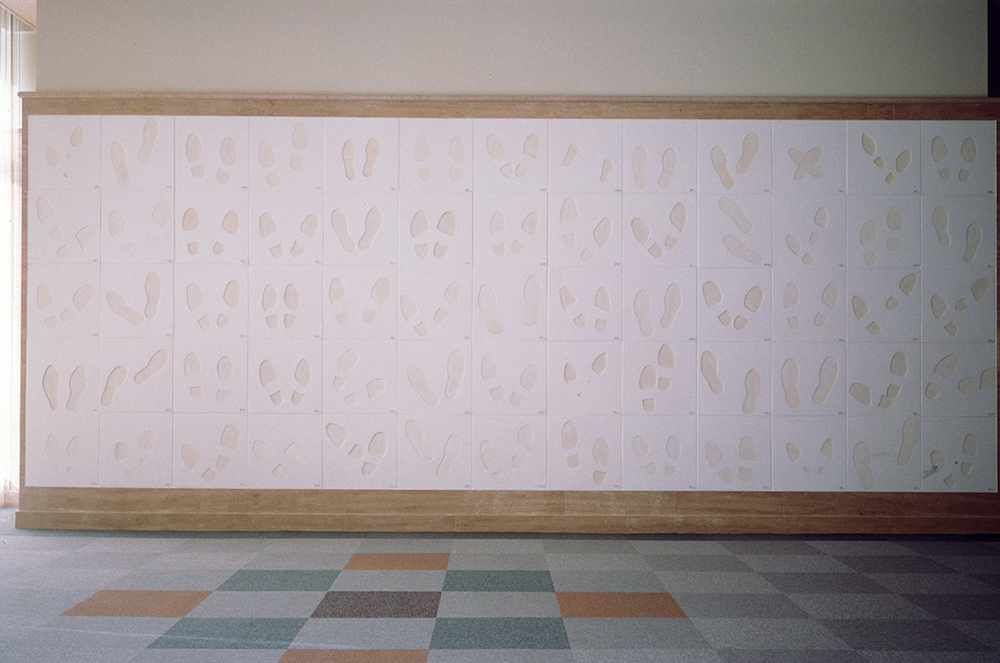
Part of the installation was later acquired by Mitsubishi Estate and installed permanently at the lobby of a high riser located at Roi 1, Yokohama.
Below an interview with Fumio Nanjo in Japanese taken from the book that was published along side with the exhibition in Tokyo.
Scroll down for English please.
Interview FUMIO NANJO and EDGAR HONETSCHLÄGER 1993
FUMIO NANJO So, how many shoe prints were there in the exhibition?
EDGAR HONETSCHLÄGER 630, but altogether we made 780.
N It was quite a silent piece, wasn’t it? But at the same time you felt that you were with many people, because there were all these traces. Even if you were standing alone on that plasterfloor you did not feel lonely. For me, the combination of plaster and wax produced a very warm feeling – soft and light. When I first planned the piece -about one and a half years ago- I had a certain image of it. Still – once I saw the finished piece in front of me I was struck because there was something very innocent about it. I also thought it had some kind of Japanese sense.Of course it is very Western, the idea and everything – but for example,if you look at the structure – I had chosen old Japanese measurements – eight of those plates make up exactly one tatami mat.
FN I did not feel that it looked “Western” , but it did not look very Japanese to me either. It is quite different from Western types of works.It must have something to do with the materials.
EH Yes, but many Western artists are using plaster- it cannot just be the material. Probably it has something to do with the rigidness. On the one hand, there is this confusion, because all these shoeprints are very very different but the system is very clear.
FN Looking at it and walking on it evoked different kinds of feelings. When I walked on it I felt very happy, because I had to be very careful.In the beginning this meant that I did not have to care until I broke one. Then I started to be careful and I started feeling very nervous. It was shifting and moving slightly – I realized that it was very fragile.
EH Yes, the fact that the plates were easily breakable can be a kind of symbol for society as well, if one wants to see it that way. In society, some people break and others don’t. One visitor said that walking on the plates was like walking on eggs. People could not step into the center of the plaster plates – I had them walk along the edges, that is, the spaces between plates. Of course I wanted to have people feel the sensation of walking directly on the plates – I was referring to the Japanese tradition of taking off one’s shoes when entering one’s home and traditional places, like sentos (public bathhouses) and otera (temples). Japanese have always considered it to be comfortable to take off one’s shoes and walk barefoot on the tatami.
FN I think if you stand on the other person’s footprint, it has another meaning in a sense because you are” performing” another person.So it is kind of a metaphor for many things. But actually you need not physically do this, it in reality, like when we say figuratively, “put yourself in my shoes.”
EH I have read that in former centuries, in the Emperor’s residence, people had to walk in straight lines on the tatami .
FN Yes, but they could not walk along the borders of the tatami. It is the reverse of how people had to walk on your work – but it is the same thing in terms of their being certain limits.
EH During the “ performance” people were being asked to step into the 45 x 45 cm semi-dry plaster plate with their shoes on. The set-up was very strict to a certain extent, because I would say, “ Okay, this is the amount of space and here you can express your individuality “. I believe that a society can function only if everybody has a certain amount of space. But then of course there were a lot of people, especially Westerners ( I have to say), who said, “ Oh, how can you do this because you give me a frame -how can I show my individuality within such a small, rigid framework? So, your theory is wrong.”
FN That’s interesting.
EH I replied, “ Of course you can. I mean, if you like, you can step out of the frame. There are millions of variations on how you can do it”.
FN So I think that the piece has both a negative and a positive side to it. If you just see the system–the rules and frames we have to obey– it is very depressing. But if you see the variation of shoeprints, the variety of people’s impressions, there is individualism as well. So there are two sides to this work. It depends on the viewer to determine which side looks more apparent . Actually it tells the viewer’s opinion, his way of thinking, in a sense.
EH That was my wish. At the same time it shows that individualism is a very relative thing.The accumulation of those 780 “relics” shows that even though there is a never- ending possibility of permutations , they are not so different from each other at all. More or less they are all the same.Everyone tries to express his or her individualism – but how far does it go?
FN Individualism is like fashion, I feel. Because through fashion, people try to express that they are a little bit different from others. So fashion might help to show some differences. If you believe that individualism is so meaningful, this is odd, because in the end, you are a human being. There are lots of frames – whether you like it or not. So you are in that framework and you cannot get out of it, and individualism is always in that small frame . Starting with physical aspects – you are given the color of skin, height, face, whatever, and you cannot change these things drastically.
EH In a physical sense – yes. But even beyond this, everyone creates his or her own framework and restrictions. You surround yourself with people — to a certain extent we have the chance to choose our environment –the kind of people you like or need. This is what forms our ego and our position within the society – which again depends on the surrounding framework.
FN Like through one’s work – for example, your work. You are expressing your idea, your concept , your way of thinking about society and the system you are part of. From that point of view , individualism very much becomes a question of distance and difference.With your ideas and thoughts you have a chance to enrich society.Particularly in our post-modern society, where everything is being controlled by mass production and economic efficiency, where people’s daily lives are totally controlled. Work from 9 to 5 in the most efficient ways – where maximal production has the highest priority – everything is being controlled by purely economical ways of thinking. Art does have the ability of opening people’s eyes to different points of view, in its best sense, it allows us to look at ourselves from different angles, and therefore raises awareness.
EH But the artist himself is bound to a framework just like anyone else. Firstly because of his fairly well-defined position in society – you just proved it with your remark on what the function of the arts ought to be today. The artist is sentenced to a lifetime of being an outsider and renegade. I very much agree with your definition but at the same time artists arenot that different from anybody else.Their ability to move within this system is also very limited. Making “art” is transforming thoughts into material. Even if you want to deny this – you always end up producing something – emphasis on producing- and producing is the same as consuming. We are all producers and consumers at the same time. Secondly, the artist is somehow always part of the so-called Art World. A very small world – sometimes very narrow minded, self-indulgent and incestuous- the smallest percentage of the population imagineable. The artist depends on this world, which obviously effects his way of thinking, and as a result, his art. People who do not face this fact are naive – the terrible word “compromise” is mounted onto all of us from the day we are born.
FN In the Middle Ages in Japan, very often a certain high class samurai withdrew from society and lived outside the city near the mountains — so-called “Sato”. Suzuki Daisetsu, the greatest master of Zen, who promoted Zen in the Western world in the beginning of this century, wrote about this. He said that this person is like a hermit, but in reality, he is not, because he does not live in the mountains.He is outside the city and from there he looks at the city. People come to visit him but later return to the city. This is important . He should not be completely isolated. He is an “outsider” , but he is watching and commenting on the people in the city, the people in the center. This is “WABIZUMAI” , a simple life.
EH I understand very well what you mean, because when I lived in New York the first two years I stayed in Brooklyn – very close to Manhattan. It was very inspiring for me to live outside the city, where everything is happening. I had the chance to look at the center, like looking at an anthill. I found a different way of perceiving things.
FN But now you are in.Sometimes it is difficult to have a different point of view from outside. Artists and the role of art are changing due to the situation.
EH One of my aims with this project was trying to get out of the ivory tower –to get out there onto the street . I tried to approach the so-called common people, and the response was overwhelming. People waited up to three hours for their turn. Everybody who helped organize this project, including myself, had expected that people would be too shy, scared or worried about their shoes–but the opposite happened. But coming to see the show at Sagacho was something different. Maybe a little more than 10% of these passersby who had participated in the performance and had made their own piece of art, actually came to see the show. Probably most of them had never been to an art gallery before. The rest of the visitors were part of the Art Scene as usual. There is definitely some fear about art, particulary contemporary art, and the institutions where it is being presented. Maybe because it is still considered something very elite
FN The concept itself, I think, was very clear and easily understandable, and the piece in its appearence was also very beautiful.
EH Yes, that’s actually something I am fighting for a little bit. I believe that a combination of beauty and substance is possible. It is something which seems to have been abandoned these days. I think that this is one of the reasons why I feel quite comfortable in Japan. Before I came to Japan some art critics asked me, “Why are you going to Japan? Everything is so decorative there.” I always had a sense for beauty and the architecture and arts of ancient Japan prove that a symbiosis does exist. Decorative and beautiful belong to different pairs of shoes.
FN The content and the appearance of works of art are often discussed separately. But actually in a good work those two are the same. We use the words ”wabi” and ”sabi”.
EH Wasabi?
FN No, no.
EH Inside and outside?
FN No, no – its kind of aesthetics, a philosophy, in Japan. “Wabi- sabi” is something simple and ordinary, a refined sort of beauty. It is when we feel really deep inside a sort of beauty. It is not a very gorgeous beauty. Usually it is very sober and minimal and ordinary. Japanese teacups sometimes seem to be kind of deformed – naturally twisted as a result of the firing process. You have to see the beauty in such an ordinary unpretentious way of presentation.This kind of thing is called “wabi.” If you see this beauty in a very old object, this feeling is called “sabi.” We use these terms for the tea ceremony, but not only in that context. It is not just about the object, it also includes the spirit of how people live.
EH I agree with this philosophy. But beyond that, the combination of beauty and content is best. Also, I think there is a task for the artist in terms of aiming at social and political change, not in terms of revolution, but in terms of the fact that the artist is one of the few people within society who looks at things and contemplates them. The artist has to make people more aware of what is happening within society. Without art people sometimes don’t notice what is happening around them. I know this might sound very idealistic, but this, I think, is the task of the artist.
